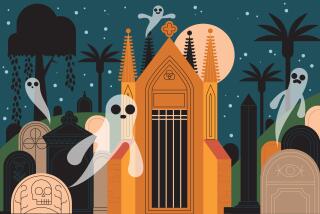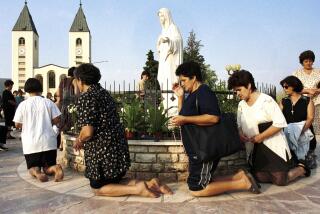Milking the Legend of a Weeping Apparition
- Share via
Would you buy soap from Jeffrey Dahmer or a used car from Ted Bundy? No? Then would you drink milk on the recommendation of a weeping ghost who murdered her children?
That’s what California milk producers are about to find out. Beginning Monday, the milk board famous for its “Got Milk?” campaign will initiate a $2-million advertising blitz featuring La Llorona, the subject of a Latin American legend about a woman who killed her children, then herself, after losing her husband’s affections.
The legend is so deeply embossed on the fabric of Latin culture that all it takes to correct a wayward child is for a parent to warn, “If you don’t behave, La Llorona will come for you.”
In the commercial, the shrouded ghost goes to the refrigerator for milk and, finding the carton empty, goes off weeping. If the idea is radical, the team behind it is just as unusual. The campaign was developed by four Latino students at the Art Center College of Design in Pasadena.
For Tania Sosa, the project was the chance of a lifetime.
“It’s overwhelming,” said the 27-year-old woman who lives in Marina del Rey. “I never thought I’d have a commercial so soon.”
Though pleased that Sosa and her fellow students incorporated a cultural legend in a mainstream ad campaign, some in the Latino community wonder if it makes sense.
“My grandmother used to say, ‘La Llorona is coming to get you,’ ” said Gabriela Lemus, director of policy for the League of United Latin American Citizens in Washington. “I don’t know if I’d buy milk from someone who was trying to kill me.”
The only word spoken by the ghost is leche, Spanish for milk. But producers are confident that the “Got Milk?” campaign is so well imprinted that it won’t be a problem for non-Spanish speakers.
Jeff Manning, spokesman for the California Milk Advisory Board in Berkeley, said the ad will represent one of the few times that Spanish has been used to sell a product on English-language TV.
Though recognizing that the choice of a murderous ghost as a pitchwoman could be controversial, milk board officials said it would have been indefensible to do nothing in the face of statistics showing that teenagers are drinking less milk.
“Are we taking a chance? Absolutely,” said Manning. “I hope it’s an intelligent risk.”
He said that teenagers are a large part of the milk market but that consumption is “trending down.” They drank milk about 4.5 times a day in 2000, down from 6.9 times a day in 1993, according to the board. Part of the reason might be that youths are also eating less cold cereal, the board says.
Worried about this trend, producers commissioned a study two years ago to find out what was going on. They got good and bad news.
On the one hand, Latino teenagers, especially the critically important bicultural youths whose families had been in America a generation or two, were very familiar with--and liked--the “Got Milk?” campaign. They could even recall early spots such as the one showing a young man eating a peanut butter sandwich trying to answer the phone-quiz question, “Who shot Aaron Burr?”
On the other hand, that didn’t make them drink more.
That left the producers and advertising people in a quandary. Penetration and likability are measures of success, but they aren’t success. So they decided to use kids to sell to the kids, contacting Art Center and offering to let students design the campaign.
The center gathered together four Latino students: Sosa, Jose Rennard, David Delgado and Ali Alvarez. Though they were older than the target audience, Manning said, they were young enough to know the culture, yet sophisticated enough to brainstorm effectively.
Sosa said one advantage was that they came from a variety of backgrounds. Her father was an architect in Mexico City. Another student’s family owns a restaurant chain, Fiesta Grande. Another is half-Irish, half-Argentine.
“We had a lot of sleepless nights,” Sosa said. “We would get together with a ton of coffee” at a restaurant in Hollywood. Initially, they came up with 23 ideas.
One that wasn’t accepted revolved around a jalapeno-eating contest. Another featured a contest between dueling disc jockeys trying to knock a glass of milk off a speaker. The La Llorona idea came up early.
“All of us knew the story,” said Sosa. “That’s how we knew we might have something.”
They went to San Francisco and pitched it to Manning and Jeff Goodby of Goodby, Silverstein & Partners, which launched the original “Got Milk?” campaign in 1993.
“I think he was kind of scared” of the idea, Sosa said of Goodby. “It’s a really gross story.”
The legend surrounds a young woman who bears her husband two children. Afterward, he loses interest in her and she becomes disconsolate. Out of her head, she drowns her children. Then, realizing what she’s done, she kills herself. Now a spirit, she stalks the Earth looking for her children.
Lemus of the League of United Latin American Citizens said the commercial is not offensive.
“I understand she’s a symbol,” said Lemus, who holds a degree in marketing. “From an artistic perspective, it’s really a powerful legend.”
She’s just not sure how it will stimulate the appetite.
For the moment at least, milk officials don’t consider that a problem. For one thing, a primary target is Latinos who speak Spanish but watch many of the same shows that whites do. It also has the advantage of doing something radically different.
“People are familiar with ‘Got Milk?’ ” said Manning. The problem is: That familiarity makes it “progressively more difficult to surprise” the audience.
“Without question, many people who are Anglo will not understand the myth of La Llorona,” he said. “That’s a risk we’re willing to take.”
In test screenings, he said, Latino teenagers reacted with pleasure to the ad. “They thought it was interesting that we unearthed something only they knew about,” he said.
The whites in the group were puzzled. When they asked who she was, the Latinos all shouted, “She’s La Llorona.”
“If that happened in high schools around California, I’d be a happy guy,” Manning said.
The commercial will run only in California at first, but is being offered to other regions.


